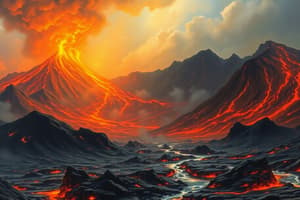Podcast
Questions and Answers
Which process involves the transfer of heat energy through collisions between neighboring atoms or molecules in solids?
Which process involves the transfer of heat energy through collisions between neighboring atoms or molecules in solids?
- Folding
- Conduction (correct)
- Convection
- Radiation
What is the main source of Radiogenic Heat as mentioned in the text?
What is the main source of Radiogenic Heat as mentioned in the text?
- Radioactivity (correct)
- Accretion
- Magma
- Mantle
What type of fault is formed by the downward displacement of a fault-bounded block?
What type of fault is formed by the downward displacement of a fault-bounded block?
- Normal fault (correct)
- Transform fault
- Horst fault
- Reverse fault
What type of rock deformation involves fracturing of an object once its strength is exceeded?
What type of rock deformation involves fracturing of an object once its strength is exceeded?
Which type of fold results in a bent rock layer that was originally horizontal and subsequently deformed due to compression forces?
Which type of fold results in a bent rock layer that was originally horizontal and subsequently deformed due to compression forces?
What is the main factor that determines the viscosity of magma?
What is the main factor that determines the viscosity of magma?
Which type of magma is characterized by a higher silica content and greater viscosity?
Which type of magma is characterized by a higher silica content and greater viscosity?
What is the principal gas dissolved in magma, accounting for more than 98 percent of all gases emitted from volcanoes?
What is the principal gas dissolved in magma, accounting for more than 98 percent of all gases emitted from volcanoes?
Which type of lava is associated with high viscosity and rough texture?
Which type of lava is associated with high viscosity and rough texture?
What factor causes magma to rise toward the Earth's surface?
What factor causes magma to rise toward the Earth's surface?
What is the main source of Radiogenic Heat as mentioned in the text?
What is the main source of Radiogenic Heat as mentioned in the text?
Which process involves the transfer of heat energy through collisions between neighboring atoms or molecules in solids?
Which process involves the transfer of heat energy through collisions between neighboring atoms or molecules in solids?
What type of fold results in a bent rock layer that was originally horizontal and subsequently deformed due to compression forces?
What type of fold results in a bent rock layer that was originally horizontal and subsequently deformed due to compression forces?
Which type of fault is formed by the downward displacement of a fault-bounded block?
Which type of fault is formed by the downward displacement of a fault-bounded block?
What factor causes magma to rise toward the Earth's surface?
What factor causes magma to rise toward the Earth's surface?
What is the dominant element in the composition of magma?
What is the dominant element in the composition of magma?
What is the principal gas dissolved in magma, accounting for more than 98 percent of all gases emitted from volcanoes?
What is the principal gas dissolved in magma, accounting for more than 98 percent of all gases emitted from volcanoes?
Which type of magma is more viscous, leading to the formation of smooth lava?
Which type of magma is more viscous, leading to the formation of smooth lava?
What factor determines the viscosity of magma?
What factor determines the viscosity of magma?
Which element controls the composition of magma due to its abundance in the Earth?
Which element controls the composition of magma due to its abundance in the Earth?
Flashcards are hidden until you start studying
Study Notes
Heat Transfer and Geology
- Conduction involves the transfer of heat energy through collisions between neighboring atoms or molecules in solids.
- Radiogenic Heat originates chiefly from the radioactive decay of isotopes within the Earth’s interior.
Faults and Deformation
- Normal Faults are formed by the downward displacement of a fault-bounded block.
- Fracturing in geology occurs when an object exceeds its strength, leading to rock deformation through breakage.
Folds and Rock Structures
- Anticlines result in a bent rock layer that was initially horizontal and is deformed due to compressive forces.
Magma Characteristics
- Viscosity of magma is primarily determined by its silica content.
- Felsic Magma is characterized by a higher silica content and greater viscosity, making it more resistant to flow.
Volcanic Gases and Lava Types
- The principal gas dissolved in magma is water vapor, accounting for more than 98 percent of all gases emitted from volcanoes.
- Andesitic Lava is associated with high viscosity and a rough texture.
Magma Dynamics
- Buoyancy or gas accumulation causes magma to rise toward the Earth's surface.
- Silicon is the dominant element in the composition of magma and significantly influences its properties.
Other Key Factors
- Magma viscosity also influences the formation of smooth lava types.
- The composition of magma is heavily controlled by the abundance of elements, especially silicon and oxygen.
Studying That Suits You
Use AI to generate personalized quizzes and flashcards to suit your learning preferences.




